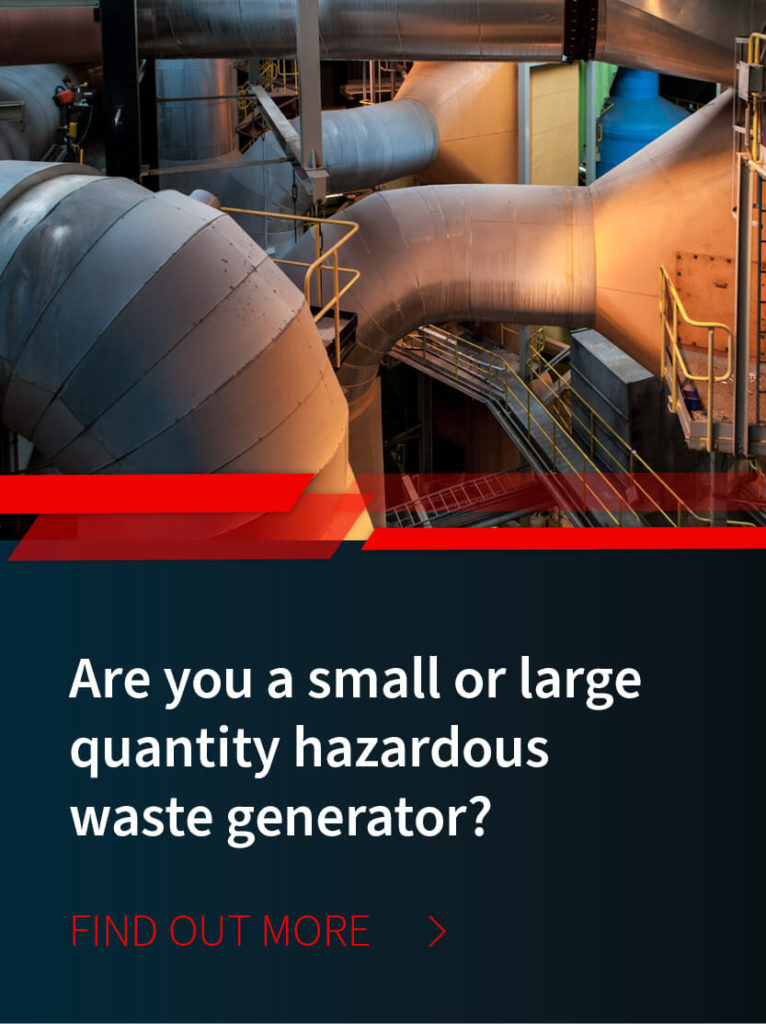
/ IN THIS BLOG
The waste management industry is highly regulated by federal and state laws. You have to obey both, which can lead to some confusion in regard to safely and legally dealing with your waste. Laws and regulations of both federal and state governmental agencies are often complicated. However, working with an experienced and knowledgeable waste management company that can address your own questions or concerns is one way to minimize that confusion.
So, does every business require a generator EPA identification number? What is that anyway?
01 / Who Needs a Generator’s EPA Number?
Does every business that relies on a waste transporter or pick-up service need a generator identification number? No. The federal Environmental Protection Agency (EPA) requires that any business or facility that produces hazardous waste obtain a generator’s ID number.
What exactly is the EPA ID number and what does it do? At its most simple definition, the Environmental Protection Agency (EPA) defines a generator identification number as ‘a unique number that is assigned to facilities that generate specified amounts of hazardous waste. The 12-character number is used by states and EPA to track hazardous waste activities.’
The EPA ID number enables hazardous waste generators and waste handlers transporting that waste to keep track of it through manifests. In essence, the ID number allows tracking capabilities from the moment the waste leaves a facility to its final point or process of disposal. This is also known as the ‘cradle-to-grave’ approach to hazardous waste management.
Refer to the Code of Federal Regulations (CFR) Title 40 Part 260 – Hazardous Waste Management System: General for additional information.
In other words, any facility or business that produces hazardous waste needs to comply with federal and state regulations regarding transportation permits, authorizations, and weight and volume limitations based on generator size. This is especially true when transported hazardous waste travels across state lines.
02 / Federal versus State Regulations
Management and tracking of hazardous waste is always important. Fines for non-compliance are massive. However, the production of hazardous waste is not a one-size-fits-all process. For this reason the EPA and state agencies define categories of hazardous waste and volume produced. For example, a hospital will likely produce more hazardous waste than a dental office so the rules will be slightly different in regard to accumulation times and volume.
The EPA defines three such categories, though some states have more than three categories. This is why it’s important to be aware of the federal and state regulations, as both must be followed.
While federal regulations dictate whether you need an EPA generator ID number, this issue also depends on your state regulations. Not all states have the same rules in this regard.
Even so, you only need the generator ID number if you’re dealing in hazardous waste. Visit the EPA website to determine which states have identical waste generator categories as the EPA. Some don’t.
03 / Waste Generator Categories - The Amount Counts
If you generate hazardous waste and have determined that you need to ship that waste off-site, you’ll need a generator’s EPA identification number based on the volume of hazardous waste you typically amass within a month’s timeframe. Typically, three factors determine whether your business needs to obtain this ID number:
The state you’re in (and often at the district or county level as well)
How much hazardous material needs to be shipped off-site
The EPA defines hazardous waste quantities. For example, very small quantity generators (VSQG), small quantity generators (SQG) or large quantity generators (LQG). However, there are times when a small quantity generator is deemed ‘conditionally exempt’.
Very Small Quantity Waste Generator
A very small quantity generator typically produces 220 pounds (100 kg) or less every month. Even so, all hazardous waste must be identified and the facility may not produce more than 1,000 kg of hazardous waste at any time. Such generators do not typically need an ID number, but some states may require it unless exempted.
Small Hazardous Quantity Waste Generator
If your facility generates more than 220 pounds (100 kg) per month but less than 2,200 pounds (approximately 1,000 kg) per month of hazardous waste, you are considered a small quantity generator, but you DO need a generator ID number, and this holds true for every state.
Large Quantity Hazardous Waste Generator
If you generate over 2,200 pounds (approximately 1,000kg) or more of hazardous waste every month, you are a large quantity generator, and you need an EPA ID number to legally ship that waste. As with small quantity generators, this number is needed regardless of state.
About the Conditionally Exempt Small Quantity Generator
If you generate less than 220 pounds per month of hazardous materials, your facility is considered a conditionally exempt small quantity waste generator, and you don’t need an EPA ID number. However, having said that, there are states where you do need that number regardless of how much hazardous waste you generate. In some states, even one pound of hazardous material is enough to warrant having to obtain the generator ID number in order to legally ship the waste.
04 / Things to Remember about the Federal EPA Identification Number
Don’t take chances and guess when it comes to hazardous waste management. Review the laws regarding hazardous waste generator requirements and on-site accumulation time limits here. In addition, remember that:
You need to have your number before you ship anything hazardous. Shipping hazardous waste without the number (when it’s required due to your status, state, or volume) is against federal regulations.
You must report your waste generator status to the federal government.
If you’re a large quantity generator, you have to ship your waste out within ninety days, and you will be liable to pay tax on the tonnage.
In the application process, the ID number is site-specific to the origin of the waste generation. If you move, you’ll need to apply for and receive a new number.
As a built-in check and balance to the system, treatment facilities can’t legally accept waste from generators who should have those federal EPA numbers but don’t.
Be aware that transportation of hazardous waste without the required manifest/s can cost a business or facility $50,000 per day, per violation, in addition to possible jail time, per 42 U.S.C. 6928(d)(5). The same applies to a generator who ships hazardous waste to an un-permitted facility. The responsibility is on the hazardous waste generator from the origination of the hazardous waste to its ultimate disposal, so make sure everyone involved in the waste management process is properly permitted and authorized.
For more information about EPA identification numbers, your potential status as a generator, and what this all means for your business, contact a representative of MCF Environmental Services, a full service hazardous waste management company.
Robert Losurdo
President, COO








